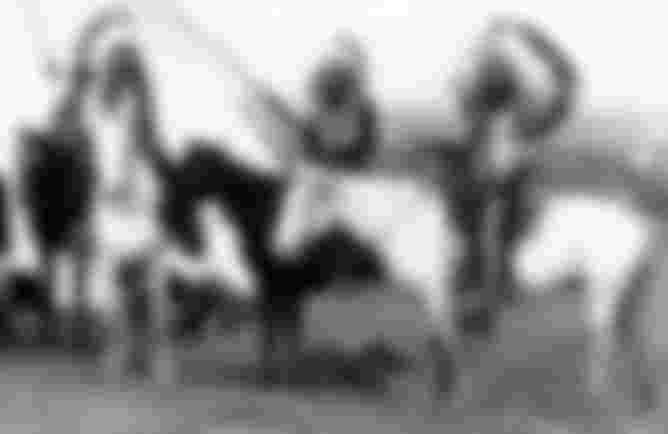SEMINOLE:
A tribe of the Muskogean family, originally from the Apalachea area who eventually settled in the Florida area. The origin of the wolf is from the Oconea tribe (near the coast of Georgia). After two war conflicts with US troops (during the first half of the 19th century), in 1858 they were moved to reserves. Culturally, they belonged to the Southeast Farmers, and when they came to Florida, they were engaged in hunting and fishing. They practiced the festival of Green corn dance…
The Plains - Great Plains Cultural Region:
The Great Plain region represented a vast, prairie area - from central Canada in the north to Mexico in the south, and the Rocky Mountains of the Midwest. Buffalo hunting was the main source of food, life and culture of this unique region, until the final destruction of bison by white savages and hunters in the late 19th century.
The stereotypes that exist about North American Indians, transmitted as unverified stories and series of prejudices of white immigrants to this day, come from these endless grassy, green areas, stories about their supposed way of life of cruel savages, their appearance and culture - their feathers stuck in their hair. , their colorful ribbons and feathers, long hair, their bows and arrows, spears, tomahawks and other weapons for hunting bison, bears and deer, their tepee tents (folding and very practical leather tents, convenient for use by nomadic and hunting people who constantly moved from various needs and desires), deerskin clothes with famous fringes and ornaments (which fluttered in the wind as symbols of freedom and fearlessness of their indomitable spirit), their beads and decoration with various colors, their pipes and magical, ceremonial dances, moccasins, smoke signals…
There are many tribes that wandered and lived freely in this area until the appearance of white savages, tribes that then went to the eternal hunting grounds and legend, the unfulfilled dream of life: Sarcee, Plains Cree, Blackfoot, Assiniboine, Gras ventre, Hidatsa, Crow (Crows ), Mandan, Yanktonai Sioux, Santee Sioux, Yankton Sioux, Teton Sioux, Arikara, Shoshone, Cheyenne, Ponca, Omaha, Pawnee, Oto, Arapaho, Kansa, Missouri, Kiowa, Osage, Quapaw, Comanchie, Wichita, Kichai, Lipan Apache.

KAJOVE:
A warlike nomadic tribe of prairie Indians, which penetrated from the Black Mountains to the south and ruled the prairies. Today there are about 12,000 of them. The name Kiowa in their language means the main people. They called themselves Kwu (leaving), alluding to frequent forced departures before the onslaught of the superior tribes of Chippewa, Sioux, and Cheyenni. They traded with tribes that, as a rural population, grew corn and sold it to nomads. The Kayos are said to have been the most dangerous North American Indians, very well organized as warriors. As a typical prairie tribe, they hunted bison (buffalo). The bow and arrow were their main weapons. They owned a large number of horses and lived in portable leather tents. The Kai were deeply religious. After they took over the "Dance of the Sun" ceremony from the Vrana tribe, it became the center of faith for them. They believed in visions and dreams, and in the rituals they used hallucinogenic opiates obtained from the peyote cactus. Later, they took over the "Dance of the Ghosts" ceremony.
CHEEN (Cheyenne):
They represent one of the most important prairie tribes of the Algonquin genus, which wandered around the rivers Platte and Arkansas. They were bison hunters, with a bow, arrow and spear, as their main weapons. They raised horses and lived in tents (wigwams). Before 1700, they lived in what is now Minnesota. There they planted, hunted and collected wild rice. They later moved to the Cheyenne River area of North Dakota, where they caught horses and began hunting bison. At the end of the 18th century, under pressure from the Sioux tribe, they moved further west. The road led them to the river Platte. After the conflict with European immigrants and later, the American army (after the formation of the USA in 1776), at the end of the 19th century, they were placed in the current Tongue River reserve. Today, there are about 11,500 of them left, "carefully" housed inside modern camps for the disobedient and unsuitable „

BLUND KNIFE (1820-1879)
He got his name as a young warrior when he managed to kill a grizzly bear with a knife. He was a simple, harmless, determined and brave man, a just hero of his people, uninterested in acquiring material goods. He was the chief of the old smithy — brave, selfless, determined, intelligent. He became known for his heroic deeds, esteemed as an honest and noble leader of the people… Around 1875, whites widely promoted the idea of imprisoning all Indians in reserves, without the right to property they owned and the rights guaranteed to them. Greedy, perfidious, deceitful and evil white newcomers wanted above all the fertile Indian territory and natural resources of America… From the warlike Apaches to the peaceful Pierced Noses, all Indian tribes from the fertile plains were persecuted and killed without mercy. The U.S. government made the decision to disarm the Indians and move them to the reserves. The deportation was carried out by force, without mercy and a shred of humanity…
Chief Tupi Nož's request to return his tribe to the land of his ancestors was flatly rejected - the authorities considered him a dangerous man, so in 1876 he and his exhausted people were forcibly banished to the reserve… A sudden change led to the death of the Cheyenne people. Then the Blunt Knife makes the decision to lead the Cheyenne north to the land of their ancestors. The Cheyenne thus showed their indomitable spirit again. Despite the fact that they managed to reach the ancestral lands, they were eventually surrounded by the US military and taken to the reserves. In the end, determined to die for freedom, they desperately try to escape from the camp (reserve).
In the last life's struggle for dignity and freedom, the brave Cheyennes and their fearless leader perished.
LITTLE WOLF
If any nation ever fought for justice and freedom, it was the brave Cheyennes… If mankind ever saw true physical and moral strength, then it was the Cheyenne people, led by Chief Little Wolf. Little Wolf was as dignified and kind as all the natives of North America. Measured and polite in addressing his interlocutors, he was an example of a skilful and brave Indian leader. After the Cheyenne were moved to inhumane reserves from their fertile and bison-rich plains (reserves "enriched" by malaria and scarcity), the Little Wolf led his people north along the path of freedom and salvation from death and humiliation. His brave rebellion is measurable with the great deeds of great chiefs like Joseph and the Blunt Knife.

Before leading the people north, he bravely addressed the manager of the Despair Reserve with the following words: "Listen to me, my friends! I have been friends with white people for a very long time. I don't want blood being shed in this reservation. I'm going north to my homeland. If you want to send soldiers after me, I'd like you to let me get away at least a little bit. And then, if you still want to fight, I will be at your disposal. "
In the end, the Little Wolf took his tribe on a final journey and a decisive battle for freedom and dignity. Blunt Knife, as one of Cheyenne's leaders, headed for the Red Cloud Reserve and surrendered to the white soldiers at Robinson's Fortress, facing his sad fate. Little Wolf spent the winter in Sandy Hills full of game. He then went to Montana, the Pine Wreath area where the Cheyennes lived in peace. They were later transferred to the Lame Deer office in Montana, where Little Wolf spent the rest of his life. Behind the clouds of racial prejudice lies the bright sky of freedom, and on that supreme court, parts of the tribal soul, such as the soul of the Little Wolf, have their place of honor!
COMANCHES:
An Indian tribe inhabited during the 19th century in the southern prairies of West Texas, today lives in Oklahoma with the Kiowa and Apache tribes. By language they belong to the Uto Aztecan family. The name Comanche itself is probably from the language of the Hopi Indians, which could be translated as "scalp curl". Their ancestors inhabited the Yellowstone area. They became known as the owners of large herds of horses, in the early 18th century in New Mexico. By invading Texas, they expelled the Apaches and entered into a formal alliance with the Kai and Cheyenne. In the middle of the 19th century, they signed the first treaty with the USA and were placed in a reserve. Former warriors have become very active in the American economy today. Their participation in the First and Second World Wars as part of the American Thunderbird Division should also be pointed out.
The Comanches were a typical prairie tribe that made a living from hunting. In winter, they hunted deer, elk, antelope and small game. With the arrival of spring, they would follow the herds of buffalo. Following them, they moved constantly, placing their village in traditional circular shapes during breaks. They got food, clothes, shoes and tools from the bison - they also used the prey in trade, exchanging it for tobacco, honey and other things. They hunted bison mostly with long spears. The lifestyle of the Comanche was marked by hunting, war and great love for women, who prepared food and took care of the household and children. They were religious - they highly valued the vision. People with a lot of knowledge and strong vision became Indian sorcerers, that is. shamans and engaged in rituals of healing and predicting future events.
CROWS (Crow):
The Siouan Prairie Tribe of the Yellowstone River and its tributaries, today in the Crow Reserve in Montana. They are descended from the Hidats or Great Belly of Missouri, from which they separated in the 15th century. Crows, like their Sioux neighbors, are typical prairie bison hunters and skilled riders. Their dwellings are leather tents. Their lives revolved around horses and bison. The buffalo provided them with clothing, footwear, plenty of food, tents, blankets and shields. The meat was dried and canned. They wore clothes made of deer, elk and buffalo skin. Their religion was shamanic. Sun dance and Medicine bundle ceremonies symbolized their prairie culture.

BLACK FEET:
The Black Feet are a confederation of Algonquin tribes, living in the 19th century between Northern Saskatchewan in Canada and Missouri in Montana. They got the name blackfoot after their black moccasins. The Blackfoot community consisted of 3 main tribes: the Siksika or northern Blackfoots, Piegan and Kainah or Blood. Everyone speaks languages from the Algonquin family. Their culture is typically prairie. They are hunters of large mammals, first of all bison, then deer and a lot of game. They ate fish only as a last resort. During the summer, they lived in large camps, hunted buffalo and performed the Dance of the Sun ceremony. Each tribe had a supreme chief (leader). Religious life referred to the Medicine bundle, a search for a vision that opposes supernatural forces.
From the glorious past, numerous, fighting warriors and hunters, almost nothing remained until the end of the 19th century - with the extermination of bison by the pale-faced, they began to starve, forced to live in reserves and sedentary life. The world they had been creating for centuries was rapidly disappearing, along with themselves.




Beautiful story